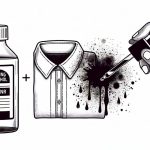To remove acrylic paint from polyester fabric, act quickly! Start by scraping off excess paint gently and rinsing the stained area with cold water. Soak the fabric in warm water for about 30 minutes, then apply rubbing alcohol or dish soap directly to the stain. Gently agitate the fabric, rinse, and check for remaining paint. Wash in cold water on a gentle cycle, and air dry. Want more tips on effective techniques?
Table of Contents
Key Takeaways
- Quickly scrape off excess acrylic paint with a plastic scraper while holding the polyester fabric taut to prevent damage.
- Rinse the stained area with cold water, then soak the fabric in warm water for at least 30 minutes to loosen the paint.
- Apply rubbing alcohol or a dish soap and water mixture directly to the stain for effective emulsification and paint breakdown.
- Machine wash the fabric in cold water on a gentle cycle with mild detergent, then air dry completely before inspecting for remaining stains.
- If stains persist, consider repeating the cleaning process or seeking professional help to avoid fabric damage.
General Considerations for Stain Removal
When you’re dealing with stains, it’s crucial to act quickly, as the sooner you address the issue, the better your chances of successful removal.
First, identify the type of fabric and the stain; knowing these details helps you choose the right approach. Always test any cleaning solution on a hidden area to avoid damaging the fabric.
Identify the fabric and stain type to select the best cleaning method, and always test solutions on hidden areas first.
Use tools like a soft cloth or sponge to gently lift the stain, rather than rubbing it, which can spread the paint. Keep in mind that heat can set the stain, so avoid using hot water or a dryer until the stain is completely gone.
Finally, stay patient; some stains may require multiple attempts for complete removal.
Pre-Removal Steps for Acrylic Paint
Before you start removing acrylic paint from your polyester fabric, take a moment to scrape off any excess paint carefully.
Next, rinse the stained area with cold water to loosen the remaining paint.
Finally, soak the fabric thoroughly to prepare it for deeper cleaning.
Scrape Off Excess Paint
Start by gently scraping off any excess acrylic paint from the polyester fabric using a plastic scraper or a blunt knife.
Hold the fabric taut to prevent it from stretching or tearing.
Begin at the outer edges of the paint stain and work your way inward to avoid spreading the paint further.
Use light, controlled pressure to lift the paint without damaging the fibers.
If the paint is dry, you may need to apply a bit more pressure, but be careful not to harm the fabric.
Once you’ve removed as much paint as possible, check for any remaining bits.
Properly dispose of the scraped-off paint to keep your workspace clean and ready for the next steps in the removal process.
Rinse With Cold Water
After scraping off the excess paint, it’s important to rinse the stained area with cold water. This step helps to remove any remaining paint particles and prevents the stain from setting further.
Here’s how to do it effectively:
- Position the fabric: Hold the stained area under a steady stream of cold water, ensuring the water flows from the back to the front.
- Gently agitate: Use your fingers to lightly rub the fabric, helping to lift the paint from the fibers.
- Inspect the stain: Check the area to see if the paint has lifted before moving on to the next step.
Soak Fabric Thoroughly
To effectively remove acrylic paint from polyester fabric, soaking the stained area thoroughly is vital. Start by filling a basin or sink with warm water, guaranteeing it’s deep enough to submerge the fabric. This helps loosen the paint’s grip. Place the stained fabric in the water and let it soak for at least 30 minutes. Gently agitate the water to encourage the paint to lift away.
| Step | Action |
|---|---|
| 1. Fill Basin | Use warm water for soaking |
| 2. Submerge Fabric | Guarantee the stained area is covered |
| 3. Soak Duration | Allow to soak for 30 minutes |
| 4. Agitate Water | Gently move the fabric in water |
After soaking, you’re ready for the next cleaning step!
Effective Cleaning Agents to Use
While tackling acrylic paint stains on polyester fabric, choosing the right cleaning agents can make all the difference.
Here are three effective options to evaluate:
- Rubbing Alcohol: This solvent can break down the paint, making it easier to lift from the fabric. Apply it directly to the stain with a cotton ball.
- Dish Soap: A gentle yet effective cleaner, mix dish soap with warm water. This solution can help emulsify the paint, facilitating its removal.
- White Vinegar: Known for its natural cleaning properties, vinegar can help dissolve the paint while also deodorizing the fabric. Just mix it with water before applying.
With these agents on hand, you’ll be well-equipped to tackle those stubborn acrylic paint stains!
Removal Techniques for Stubborn Stains
Choosing the right cleaning agents is just the beginning when it comes to removing stubborn acrylic paint stains from polyester fabric.
Start by gently scraping off any excess paint with a plastic scraper or your fingernail to avoid damaging the fabric.
Gently scrape away excess paint using a plastic scraper or your fingernail to protect the fabric.
Next, apply your chosen cleaning agent directly to the stain and let it sit for about 5 to 10 minutes.
Use a soft-bristled brush or cloth to dab the area, working from the outside in to prevent spreading the stain.
Rinse the fabric under cool water to lift the paint, repeating as necessary.
If the stain persists, consider using a mixture of warm water and dish soap for additional cleaning power.
Always test any solution on a hidden area first!
Washing and Drying Instructions
After treating the acrylic paint stain, it’s crucial to wash the polyester fabric properly to guarantee all remnants of the paint and cleaning agents are removed.
Follow these steps for effective washing and drying:
- Machine Wash: Use cold water and a gentle cycle to protect the fabric’s fibers. Add a mild detergent to boost cleaning power.
- Air Dry: Avoid using a dryer, as heat can set any remaining stains. Lay the fabric flat on a clean, dry towel to air dry completely.
- Inspect: Once dry, check for any remaining paint. If you spot any, repeat the treatment process before drying it again.
Handling Stubborn Stains
When you’re faced with stubborn acrylic paint stains, you might need to repeat the treatment process several times for the best results.
If that doesn’t work, consider reaching out to professional cleaning services that specialize in fabric care.
Just remember to be aware of any potential damage to your polyester fabric during the removal process.
Repeat Treatment Process
If the initial treatment doesn’t fully remove the stubborn acrylic paint stain from your polyester fabric, don’t get discouraged; you can repeat the process for better results.
Here’s how to tackle that pesky stain again:
- Reapply the solvent: Use a fresh cotton ball or cloth to apply your chosen solvent, ensuring it penetrates the paint.
- Gently rub the area: With a soft brush or cloth, gently rub the stained area in circular motions, allowing the solvent to work its magic.
- Rinse and check: Rinse the fabric under cold water to see if the stain has lifted. If not, repeat the previous steps until you achieve the desired outcome.
Persistence is key when dealing with stubborn stains!
Professional Cleaning Services
Sometimes, despite your best efforts, stubborn acrylic paint stains just won’t budge. If you’ve tried everything and the stain remains, it might be time to call in professional cleaning services.
These experts have specialized equipment and knowledge that can tackle tough stains without damaging your polyester fabric. They often use advanced techniques and solvents that you mightn’t have access to at home.
When you hand over your fabric to professionals, they’ll assess the fabric type and stain before applying the right treatment. This way, you increase your chances of restoring your item to its original condition.
Fabric Damage Awareness
While tackling stubborn acrylic paint stains can be frustrating, it’s crucial to be aware of the potential for fabric damage.
If you’re not careful, your efforts to remove the stain can lead to further issues. Here are three key points to keep in mind:
- Color Fading: Using harsh chemicals may strip the vibrant colors from your fabric, leaving it dull.
- Fabric Weakening: Over-scrubbing or using excessive heat can weaken the fibers, making them susceptible to tearing.
- Texture Alteration: Aggressive cleaning methods can change the texture of the polyester, resulting in an uneven surface.
Professional Help and Options
When tackling stubborn acrylic paint stains on polyester fabric, seeking professional help can often save you time and frustration.
Experienced cleaners know the best techniques and products specifically designed for removing paint without damaging your fabric. If you’re unsure about DIY methods, consider taking your item to a dry cleaner with expertise in stain removal. They can assess the stain and determine the appropriate treatment.
Many professionals also offer consultations, allowing you to discuss the best options for your fabric type. Additionally, some companies specialize in fabric restoration, providing tailored services that can rejuvenate your polyester.
Preventative Measures for Future Stains
To prevent future acrylic paint stains on your polyester fabric, take a few proactive steps before you start any painting project.
Here’s what you can do:
- Wear an apron: Donning an apron can shield your clothes from accidental splashes and drips, keeping your fabric safe.
- Use drop cloths: Lay down drop cloths or old newspapers around your work area. This creates a barrier between paint and your surroundings, minimizing the risk of stains.
- Choose paint-friendly attire: Opt for old or less favorite clothes while painting. This way, if you do get paint on your outfit, it won’t matter as much.
Final Checks and Tips for Success
Even with precautions in place, it’s wise to double-check a few things before you start painting. First, verify you’re working in a well-ventilated area to avoid inhaling fumes.
Next, test the paint on a small, inconspicuous section of the polyester fabric to see how it reacts. Have all your supplies ready—paint thinner, rags, and warm soapy water—to tackle any mishaps quickly.
If you spill paint, act fast; the sooner you treat it, the better your chances of removing it completely. Finally, always follow up with a thorough wash after treatment to eliminate any remaining residues.
With these checks and tips, you’ll be better equipped to handle acrylic paint on polyester fabric successfully!
Frequently Asked Questions
Can I Use Vinegar to Remove Acrylic Paint Stains?
You can try using vinegar to help remove acrylic paint stains. Its acidity might break down the paint, but results vary. Test a small area first to guarantee it doesn’t damage the fabric.
Will Rubbing Alcohol Damage Polyester Fabric?
Rubbing alcohol can potentially damage polyester fabric if used in excess or not diluted. It’s best to test a small, inconspicuous area first to verify it won’t harm the fabric before applying it widely.
How Long Can I Let the Fabric Soak?
Did you know fabrics can absorb up to 30% of their weight in water? You can let the fabric soak for about 30 minutes, but keep an eye on it to prevent any potential damage.
Is It Safe to Use a Hairdryer for Drying?
Yes, you can safely use a hairdryer for drying. Just keep it on a low setting, maintain distance, and avoid overheating the fabric. This helps prevent damage while effectively drying your project.
Can I Remove Paint Stains From a Dry-Clean-Only Fabric?
You can’t always remove paint stains from dry-clean-only fabric at home. It’s best to take it to a professional cleaner who can safely treat the fabric without causing damage. Don’t risk ruining your garment!
- Tetron Fabric for Marine Applications: Durability and Use Cases - June 18, 2025
- Tetron Fabric for Outdoor Furniture: Weather Resistance and Care - June 18, 2025
- Tetron Fabric for Wall Coverings: Style and Application Tips - June 18, 2025





